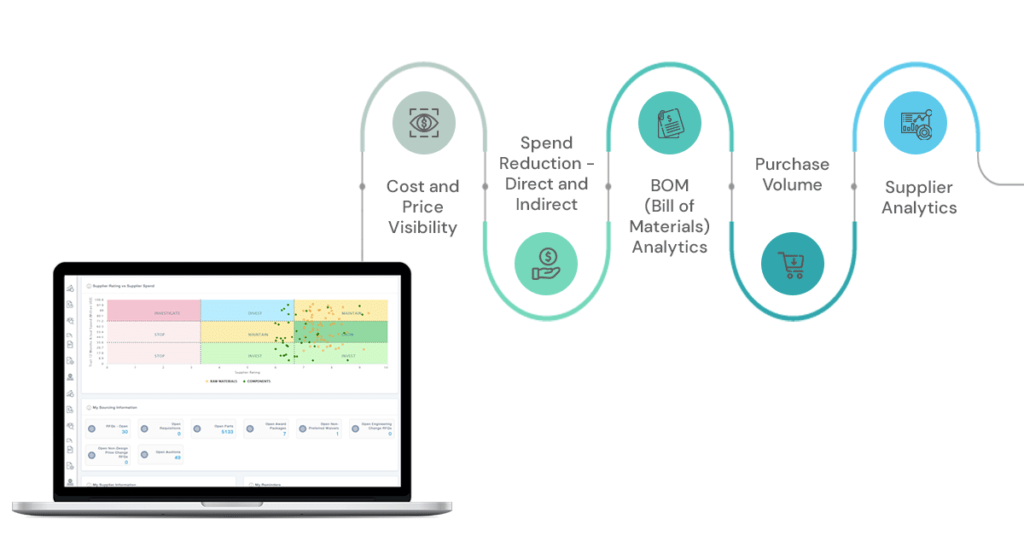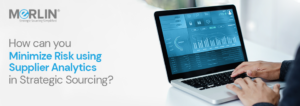Table of Contents
ToggleWhy You Need Procurement Analytics?
Procurement professionals today need to navigate volatile markets with quick decision-making. They need to pivot their models to simultaneously reduce risks and also seize new opportunities in supply chains, while also striking a balance with their mission of delivering cost savings. To tackle these new challenges, you need ways to bring more and more intelligence into every part of the procurement process. Procurement Analytics, as we all know, generate immense amounts of data across your enterprise systems. The first step in helping sourcing professionals bring more intelligence into spend management is to focus on data.
This is possible by using technological advances in automation in the sourcing and procurement space. It is easier for procurement managers to take a data-centric approach by replacing the laborious information gathering, organizing and analyzing processes that used to take weeks or even months to complete with a good analytical solution. There are numerous modern sourcing and procurement tools that facilitate these processes and enable procurement managers to uncover new insights by employing robust data analytics. These solutions help in better spend analysis, negotiations, supplier segmentation and performance management and sourcing strategy.
Evolution of Procurement Analytics
Procurement analytics has been evolving rapidly over the years from descriptive analytics to predictive and prescriptive analytics capabilities being built into modern solutions.

- Descriptive Analytics – Data is analyzed to understand “what” has happened in the past
- Diagnostic Analytics – Data is analyzed to understand “why” something has happened in the past using statistical models.
- Predictive Analytics – Trends and patterns in current and past data are used to forecast future trends
- Prescriptive Analytics – Predictive models based on procurement data are used to suggest decisions and actions to be taken
Most of the organizations today are scratching the surface by starting with descriptive analytics and progressing up the ladder. As you go up the analytics ladder, the technology becomes more complex to implement but the value delivered also improves substantially.
In this blog, we are trying to bring to you some of the most important ways in which procurement departments could leverage analytics to streamline their strategic sourcing processes, achieve cost savings and enhance their sourcing-planning and effectiveness.
One of the major misconceptions when it comes to procurement analytics is that it is all about spend analysis. But in reality, it’s a lot more. Analytics can be employed across different functions in procurement like – spend and savings analytics, category analytics, supplier performance analytics, market intelligence, sourcing analytics – bid analytics, payment analytics and so on.

How to use Procurement Analytics?
Here are the top 6 ways how procurement departments can get in on the game and use data analytics to make their buying process more efficient.

1. Spend and Savings Insights
Analytics enables you to analyze spend data and discover spend and savings patterns across categories, suppliers and regions. Insights such as spend by suppliers for items, category, region, currency, etc. can be effectively used to consolidate vendors and identify costs saving opportunities.
2. Supplier Insights
You can get a complete view of your supply base to make better buying decisions by evaluating performance, risks and bottlenecks. You can use analytics to identify excessive dependencies and diversify your supplier base in order to minimize supply risks. Supplier performance metrics like OTIF (On-Time In-Full), Quality, Share of Business etc. can also be analyzed to take better sourcing decisions.
3. Category Insights
Leveraging historical category spend data along with supplier data and combining it with external data like market intelligence can give insights to develop your category strategy and improve performance. It also drives category management strategy by helping you to identify best-in-class suppliers, create negotiation strategies specific to suppliers, and identify and avoid risk through more effective supplier qualification for different categories. More advanced systems also pull in third-party information as well as geo-political information that can impact costs in that category.
4. Strategic Sourcing Insights
Employing analytics while analyzing supplier responses can help you reduce the efforts involved in comparing bids and choosing the right supplier’s offering the best price and value to the organization. Analytics tool can process huge volumes of data and perform what-if-scenario analysis for identifying the highest-value suppliers easily thus cutting several hours of data manipulation and analysis by procurement teams.
5. Cost and Price Insights
Analytics capabilities in procurement solutions can give better visibility of pricing and cost drivers to do should-cost analysis (clean sheet analysis or cost breakdown analysis) for identifying precise alterations to procurement cost structures and schematic product designs. Procurement solutions like MeRLIN that have integrated BOM analytics enable users drill down into factors that impact price variances in a BOM. You can view and compare version history of Bill of Material – addition, deletion of parts as well as price changes across the lifecycle to identify differences. These can help organizations to generate savings through optimal product pricing and by finding more avenues to cut costs and enhance profitability.
6. Monitor Process Efficiency and Compliance
Analytics can help organizations to monitor the business process efficiency, drive purchases from preferred suppliers, identify maverick spend, increase spend under management, compare budget vs actual spend to make course corrections and much more. You can gain visibility into whether your company is actually using the contracts it has in place with preferred suppliers and buyers are adhering to spend thresholds in various categories or business units.
Conclusion
Procurement analytics thus has the potential to improve efficiency across the entire sourcing and procurement lifecycle and support procurement teams in making informed business decisions. Like I said before, your procurement process already generates vast amount of data points – internal and external. As long as this data remains inaccessible and unused, you would be missing out on several opportunities.
So, have you started your procurement analytics journey yet? If you have, then where are you in your analytics journey? Let us know if you have any other interesting use cases of procurement analytics that we have missed out here.







2 comments
Your article is very valuable for me. Hoping to read more. Thank you
Thanks for your comment. We are glad that you found this content valuable!